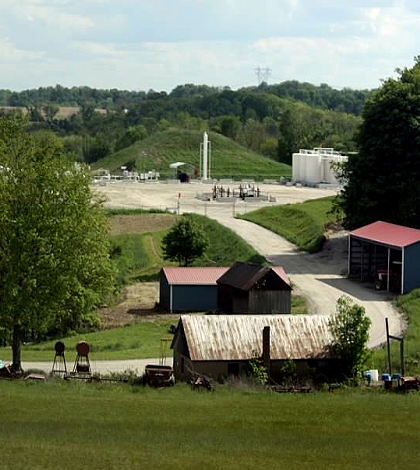Levels Of Methane In Groundwater Vary With Fracking Well Construction

Natural gas drilling site. (Credit: Amy Townsend - Small / University of Cincinnati)
As a result of the recent fracking boom in the state’s Utica shale region, Appalachian Ohio well owners have had cause to worry about the safety of their drinking water. But luckily, for a few years at least, researchers at the University of Cincinnati were able to lead a study of groundwater that gave some data on the quality of water coming out of residents’ taps, at no cost.
The project sought to measure methane in groundwater surrounding natural gas wells at sites in Carroll County, Ohio; Denver, Colo.; and Dallas, Texas. It began in 2012, when there were only three drilling sites in Carroll County, and stretched through 2015, uncovering some surprising results along the way.
“When fracking operations moved into the area (Carroll County), many residents were afraid that their water would become contaminated but they didn’t have a way to tell if or when this was happening,” said Amy Townsend – Small, assistant professor of geology at the university and the study’s lead author. “Our project provided several years of free water testing to local residents. Unfortunately … we were unable to maintain funding for the program (when the project ended). I think that state and local governments should provide this testing to local residents free of charge.”
Over the course of the investigation, Townsend – Small and other investigators from U. of Cincinnati, Carroll County Concerned Citizens and the University of California – Irvine, sampled 23 wells three to four times each year. In total, 191 samples were collected and analyzed for the methane they contained.
At each site, investigators used a YSI handheld meter to measure pH and conductivity levels in the groundwater directly. They also gathered discrete groundwater samples to check levels of dissolved methane and the gas’ stable isotopes back in their Cincinnati lab.

Amy Townsend – Small, assistant professor of geology at University of Cincinnati, discusses sampling issues with Claire Botner, right, recent graduate student at the university. (Credit: University of Cincinnati)
To measure methane, Townsend – Small and the team extracted air from the samples and analyzed the concentrations they held using a gas chromatograph. To determine the isotopes, important for gauging where the methane itself was coming from, they employed a mass spectrometer.
Bringing all the data together, they show something unexpected for the Ohio sites, given what other studies have found.
“We found over several years that methane levels and sources (indicated by methane isotopes) did not change even as more fracking sites were drilled. We found that some wells had high levels of methane, but that this methane was derived from underground coal formations, not natural gas from fracking wells,” said Townsend – Small.
That was a surprise because other studies have shown that drinking water wells near fracking wells have had higher levels of methane with an isotopic composition similar to natural gas. Recent work has shown that those wells were near faulty fracking wells, she says.
“Scientists are starting to realize that contamination of groundwater from hydraulic fracturing is not happening everywhere in the U.S., and that where it does happen it is usually because of accidents or faulty well casings,” said Townsend – Small. “However, because the federal government does not mandate testing of private groundwater wells, people living near these fracking wells are in a state of fear that their water is contaminated.”
As for the results out of Denver and Dallas, which included data on airborne emissions, they were a bit mixed. About 50 percent of methane emissions in the Denver sampling area were from cattle or landfill sources whereas the other half mostly came from fracking for natural gas. In Dallas, 64 percent of the emissions came from fracking. The rest were from landfills and cattle.
Top image: Natural gas drilling site. (Credit: Amy Townsend – Small / University of Cincinnati)





0 comments